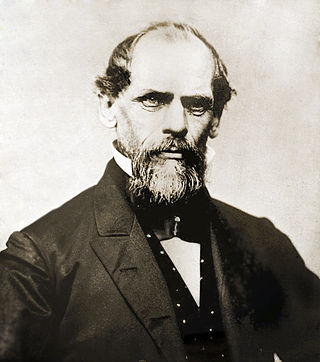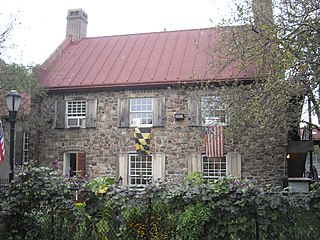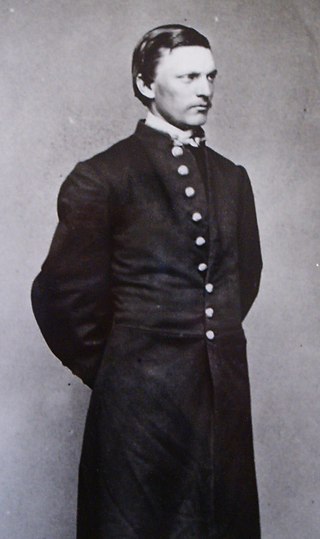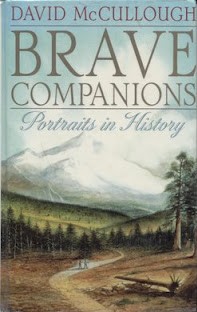
The Brooklyn Bridge is a hybrid cable-stayed/suspension bridge in New York City, spanning the East River between the boroughs of Manhattan and Brooklyn. Opened on May 24, 1883, the Brooklyn Bridge was the first fixed crossing of the East River. It was also the longest suspension bridge in the world at the time of its opening, with a main span of 1,595.5 feet (486.3 m) and a deck 127 ft (38.7 m) above mean high water. The span was originally called the New York and Brooklyn Bridge or the East River Bridge but was officially renamed the Brooklyn Bridge in 1915.

John Augustus Roebling was a German-born American civil engineer. He designed and built wire rope suspension bridges, in particular the Brooklyn Bridge, which has been designated as a National Historic Landmark and a National Historic Civil Engineering Landmark.

The Battle of Long Island, also known as the Battle of Brooklyn and the Battle of Brooklyn Heights, was an action of the American Revolutionary War fought on August 27, 1776, at and near the western edge of Long Island in present-day Brooklyn. The British defeated the Continental Army and gained access to the strategically important Port of New York, which they held for the rest of the war. It was the first major battle to take place after the United States declared its independence on July 4, 1776, in Philadelphia. It was the largest battle of the Revolutionary War in terms of both troop deployment and combat.

The Old Stone House is a house located in the Park Slope neighborhood of Brooklyn, New York City. The Old Stone House is situated within the J. J. Byrne Playground, at Washington Park, on Third Street between Fourth and Fifth Avenues. Gowanus Creek once ran nearby, but today the southeastern branch of the Gowanus Canal ends 1,300 feet (400 m) west of the house.

Dame Miriam Louisa Rothschild was a British natural scientist and author with contributions to zoology, entomology, and botany.

Washington Augustus Roebling was an American civil engineer who supervised the construction of the Brooklyn Bridge, designed by his father John A. Roebling. He served in the Union Army during the American Civil War as an officer at the Battle of Gettysburg.

Emily Warren Roebling was an engineer known for her contributions over a period of more than 10 years to the completion of the Brooklyn Bridge after her husband Washington Roebling developed caisson disease and became bedridden. She served as a liaison and supervisor of construction through communicating between her husband and on-site personnel. Her husband was the chief engineer during construction of the Brooklyn Bridge, which had been designed by his late father, John A. Roebling.

David Gaub McCullough was an American popular historian. He was a two-time winner of the Pulitzer Prize and the National Book Award. In 2006, he was given the Presidential Medal of Freedom, the United States' highest civilian award.

James Hamilton Lewis was an American attorney and politician. Sometimes referred to as J. Ham Lewis or Ham Lewis, he represented Washington in the United States House of Representatives, and Illinois in the United States Senate. He was the first to hold the title of Whip in the United States Senate.

The Niagara Falls Suspension Bridge stood from 1855 to 1897 across the Niagara River and was the world's first working railway suspension bridge. It spanned 825 feet (251 m) and stood 2.5 miles (4.0 km) downstream of Niagara Falls, where it connected Niagara Falls, Ontario to Niagara Falls, New York. Trains used the upper of its two decks, while pedestrians and carriages used the lower. The bridge was the idea of Canadian politicians, and it was built by an American company and a Canadian company. It was most commonly called the Suspension Bridge, although other names included Niagara Railway Suspension Bridge, Niagara Suspension Bridge, and its official American name of the International Suspension Bridge.

Harry Monroe Caudill was an American author, historian, lawyer, legislator, and environmentalist from Letcher County, in the coalfields of southeastern Kentucky.
David Plowden, is an American photographer who has made historical documentary photography of urban cities, steam trains, American farmlands, and small towns.
The Ojuela Bridge or the Mapimi Bridge is a suspension bridge located in Mapimí, in the Mexican state of Durango, at the site of the Ojuela Goldmine. The Ojuela Bridge was designed by Wilhelm Hildenbrand and built by the firm of John A. Roebling Sons Company, New York. Completed in 1898 the bridge was restored as a tourist attraction in 1991. It has a main span of 271.5 metres and the distance between the pylons is 315.5 metres. Currently this bridge is only used for pedestrians.

Sorosis was the first professional women's club in the United States. It was established in March 1868 in New York City by Jane Cunningham Croly.
American Portraits is an anthology radio program which aired on NBC from 1938 to 1951.

John Adams is a 2001 biography of the Founding Father and second U.S. President John Adams, written by the popular American historian David McCullough, which won the 2002 Pulitzer Prize for Biography or Autobiography. It was adapted into the 2008 television miniseries of the same name by HBO Films. Since the TV miniseries debuted, an alternative cover has been added to the book showing Paul Giamatti as John Adams. The book is available as both hardcover and paperback.
Antoine Sonrel was an illustrator, engraver, and photographer in Switzerland and Boston, Massachusetts, in the 19th century. He moved from Neuchâtel to the United States around the late 1840s, and was affiliated with Louis Agassiz throughout his career. As a photographer he created numerous carte de visite portraits in the 1860s and 1870s; subjects included his friend Agassiz, Oliver Wendell Holmes Sr., Oliver Wendell Holmes Jr., Abbott Lawrence Rotch, and sculptor Anne Whitney.
Remington Hill is a historic mining camp in Nevada County, California which prospered in the second half of the 19th century. It was named for Caleb Remington, a prominent local miner who lived mostly in neighboring Little York, where he died in 1865. It lay at an elevation of 4052 feet. It was situated around present Chalk Bluff Road about one mile south of Highway 20 and about 5.5 miles southeast of the town of Washington and 6 miles northeast of Dutch Flat, as the crow flies.

Winyah Park was the 300-acre country estate of Colonel Richard Lathers, located in the village of New Rochelle, Westchester County, New York, upon which a number of 19th-century Gothic villas and cottages designed by Alexander Jackson Davis were built. It was in 1848, after a brief but successful business career in New York, that, attracted by the accessibility and the natural environment of New Rochelle, Colonel Richard Lathers purchased a large country estate and farm along the New Rochelle and Pelham border. Three years later, in 1851, Lathers employed his personal friend and renowned architect Alexander Jackson Davis to design him a more seemly and dignified residence than the old farmhouse which existed. Revolutionizing the traditional single-house form that dominated colonial and early 19th-century domestic architecture, Davis was creating many of the country's finest villas and cottages in an entirely new, purely American style. The residence designed for Lathers was the landmark brick and marble Italian villa "Winyah", named for Lathers former estate in Winyah Parish, South Carolina.

The Great Bridge: The Epic Story of the Building of the Brooklyn Bridge is a 1972 book about the construction of the Brooklyn Bridge written by popular historian David McCullough. It provides a history of the engineering that went into the building of the bridge as well as the toils John A. Roebling, the designer of the bridge, went through with his son Washington Roebling to bring the bridge to its completion. The book went on to win two awards in 1973; the Certificate of Merit Municipal Art Society, NY, and the New York Diamond Jubilee Award.















